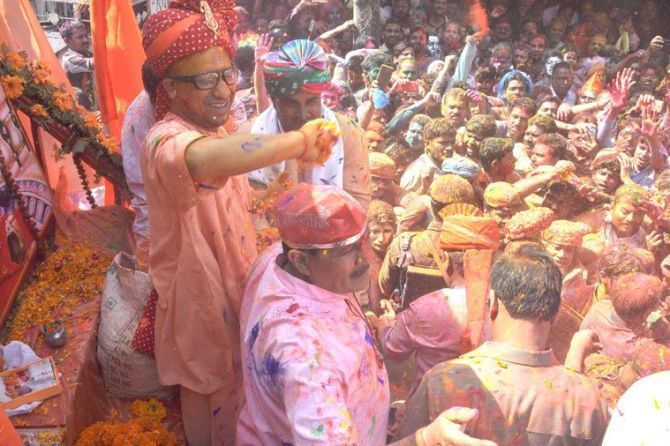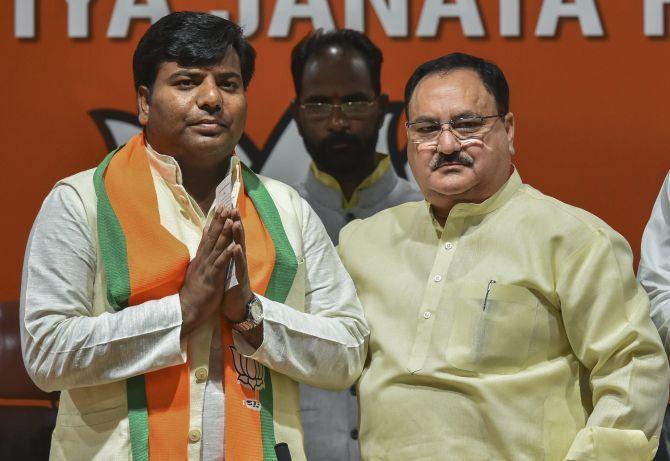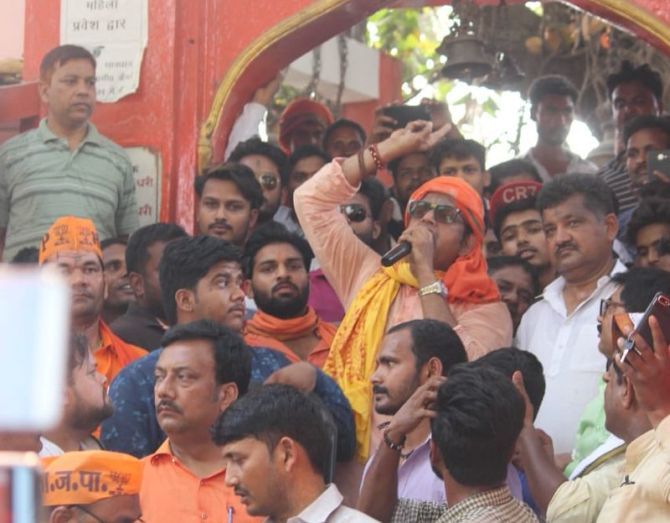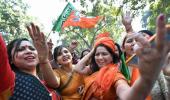Ravi Kishan, the BJP's candidate, is an outsider.
The BSP-SP candidate is from the powerful Nishad community.
Yogi faces a tough task in ensuring that the Gorakhpur seat, which he represented from 1998 to 2017, stays with the BJP.
Utkarsh Mishra reports.

This will be the first general election after 1989 when no priest from the Math will be in the race. Photograph: Kind courtesy @myogiadityanath/Twitter
In March 2018, exactly a year after Yogi Adityanath took over as Uttar Pradesh chief minister, the Bharatiya Janata Party lost his Gorakhpur Lok Sabha seat to the Samajwadi Party.
Adityanath, the mahant, or chief priest, of the Gorakhnath Math, had held the seat since 1998.
Before him, his predecessor at the Gorakhnath Math, Mahant Avaidyanath, represented the seat in the Lok Sabha four times: 1970-1971, 1989-1990, 1991-1996, and 1996-1998. He served as an Independent and a Hindu Mahasabha MP respectively in the first two terms and the latter two as a BJP member.
Avaidyanath's predecessor Digvijaynath, one of the architects of the Ram Janmabhoomi movement in Ayodhya, also represented the seat in 1967-1970.
This shows the immense clout the Gorakhnath Math holds over the constituency.
However, in March last year, after three decades, the race to Parliament in Gorakhpur didn't see a sitting mahant or his disciple contesting. So the elections were back to basics: Caste equations.
Thus, Praveen Kumar Nishad of the Nishad (or Nirbal Indian Shoshit Hamara Aam Dal) Party, who was fighting on a Samajwadi Party ticket -- supported by the Bahujan Samaj Party -- defeated the BJP's Upendra Shukla.
Shukla secured 46.5% of the votes while Nishad got close to 47%.
Last month, Nishad surprised everyone by joining the Bharatiya Janata Party, days after the Nishad Party, led by his father Sanjay Nishad, quit the SP-BSP alliance in UP.
The same day, the Nishad Party announced it would join the BJP-led National Democratic Alliance.
Praveen Nishad is now fighting the 2019 Lok Sabha elections on a BJP ticket from Sant Kabir Nagar, which goes to the polls on May 12.
It is believed he quit the mahagathbandhan in UP because the SP was delaying the announcement of its candidate from Gorakhpur.
In a conversation with Rediff.com, though Praveen hinted at leaving the SP for that very reason, he also said he wanted to be with the ruling party as, being in the Opposition, he was not able to do what he wanted for his community and constituency.
When asked if he expected the BJP to field him from Gorakhpur, he had said he "trusted the wisdom of the party leadership".
"I will do whatever my party has assigned to me," he said.
Gorakhpur will vote in the last phase of the Lok Sabha election on May 19.

Asked why the Nishad party quit the mahagathbandhan less than a week after joining it, Praveen said the party president (his father) would know better.
However, he added, "It is better to leave the place where you don't get respect."
In East UP generally, and Gorakhpur especially, the Nishad or mallah community makes a powerful vote bank.
In every Lok Sabha election since 1998, except for 2009, a Nishad candidate has ended up being the runner-up in Gorakhpur.
The Nishads and mallahs constitute nearly 23% of Gorakhpur voters, followed by 18% Muslim voters. Dalits count for nearly 3,50,000 of the over 1.9 million voters in the constituency.
An analysis of election results since 1998 shows that these votes were often divided between Nishad and backward candidates of the SP and BSP.
In the 2018 by-poll, Praveen Nishad rallied these votes behind him and thus defeated the BJP candidate, backed by the Gorakhnath Math.
In 2009, no major party fielded a Nishad candidate. Interestingly, 2009 saw actor-politician Manoj Tiwari, now a BJP MP from New Delhi, contest the seat on an SP ticket.
This time, popular Bhojpuri actor Ravi Kishan, who unsuccessfully fought the 2014 election from Jaunpur in UP on a Congress ticket, is in the fray as the BJP candidate from Gorakhpur.
Considered an outsider, Kishan is unlikely to get the kind of support Upendra Shukla received in March 2018.
The mahagathbandhan candidate is a powerful Nishad leader, Ram Bhuwal Nishad, who had contested the 2014 election as a BSP candidate.
If the BJP fielded Praveen Nishad and had he won, he could have become the second most powerful leader in Gorakhpur after Adityanath. The CM knew this and therefore didn't let Praveen get a ticket from Gorakhpur.
Once again with Gorakhnath Math priests not in the race, the election will be decided by caste equations in which Nishads, Dalits and Muslims will play a crucial role.
All this makes one wonder if the BJP should have fielded Praveen Nishad from Gorakhpur.
But it could not happen because of Adityanath's aversion to allow a strong Nishad candidate flourish in the constituency which is his citadel.
Gorakhpur-based senior journalist Manoj Singh says the Nishad voter has been completely alienated by the BJP, especially after formation of the Nishad party.
Moreover, the BJP has consistently ignored Nishad leaders and no prominent Nishad face has been in the party for two decades.
After his defeat in 2014, Ram Bhuwal Nishad joined the BJP, but could not get a ticket.
Former SP MLA Rajmati Nishad, who also contested the 2014 election, had joined the BJP along with her son Amarendra before the 2019 election, but they left the party only 42 days later.
Rajmati Nishad is the wife of former state minister Jamuna Prasad Nishad who, as SP candidate, challenged Adityanath in three Lok Sabha elections and secured the second spot each time.
In 1998 and 1999, the difference between Adityanath and Jamuna Prasad Nishad was just a little over 6,000 to 7,000 votes.
In 2007, when the BSP swept the UP assembly election, Jamuna Prasad was elected as a BSP MLA from the Pipraich assembly constituency under the Gorakhpur Lok Sabha constituency.
Jamuna Prasad had also fought the 1996 UP assembly elections on a BJP ticket from the Pipraich constituency, but he lost to muscleman politician Jitendra Jaisawal, contesting as an Independent.
After Jamuna Prasad's death in 2010, his wife Rajmati won the bypoll on an SP ticket and represented the constituency twice.
Senior Nishad leaders not finding the BJP a comfortable place has further alienated the community from the saffron fold.
"All these developments have convinced the Nishads that their politics will always be subdued till Adityanath holds the reins in the constituency," says Manoj Singh.
"The Nishad party is based in Gorakhpur and Dr Sanjay Nishad operates from here. Adityanath didn't want another centre of power in Gorakhpur other than himself. He doesn't want anyone else to consolidate his position in the constituency," Singh points out.
"If the BJP fielded Praveen Nishad from here and if he had won, he would have become the second most powerful leader here after Adityanath, owing to the large number of Nishads in Gorakhpur. Adityanath knew this and therefore he didn't let Praveen get a ticket from Gorakhpur," Singh adds.

While Praveen Nishad would have got the votes of his community, Singh believes upper caste voters, especially Brahmins, would have then ditched the BJP.
"So far, Adityanath could get Thakur, Baniya, and Kayastha votes along with some backward and Dalit votes. But the last bypoll has disturbed the BJP's winning combination," he says.
"The BJP relies on Gorakhpur Rural and Gorakhpur Urban assembly constituencies to win the Lok Sabha seat, especially the latter which voted heavily for the party. The other three assembly segments -- Pipraich, Sahjanwa and Campiyarganj -- were never easy pickings for the BJP," Singh explains.
Mahagathbandhan will get 90% of Nishad votes. Nishads are unlikely to vote for the BJP's Brahmin candidate.
So the fight may not have been easier for the BJP even with Praveen Nishad as its candidate.
But how much will the Nishad party joining the NDA benefit the BJP?
"The Nishad party has disappointed many of its workers by joining the NDA. Many believe the BJP used money power to get the party to join their alliance. But with a Brahmin candidate, the BJP will not benefit much from the Nishad party's alliance," says Singh.
In the run-up to the 2017 assembly election, Adityanath had promised reservations for the Nishad community.
Praveen Nishad had then countered him, saying the community already had reservations, and the government only needed to implement it.
Now with the BJP, Praveen told Rediff.com that the deal is done and issuance of caste certificates to Nishads will start soon.
"At some places it has already begun," he said.
But will the BJP gain the community's support with this decision?
Singh believes the Nishads either vote for the Nishad party or a candidate from their community. They will never vote for the BJP's Brahmin candidate.
"Mahagathbandhan will get 90% of Nishad votes. In 2018, the BJP lost because Nishads, Muslims, Yadavs and Dalits all voted against the BJP in tandem. The BJP's upper caste vote bank was not so consolidated. The situation was made worse by low voting in Gorakhpur City," says Singh.
"This time too, the situation is the same. The Mahagathbandhan is getting Nishad, Dalit, Muslim and Yadav votes. Ravi Kishan being an outsider has not been able to break this vote," Singh adds.
"The Congress has fielded a Brahmin lawyer (Madhusudan Tiwari) who is known locally. And he could get over 50,000 Brahmin votes, eating into the BJP's vote share," says Singh.
In a nutshell, the situation is no better from the time of last year's bypolls. The BJP will really have to work hard to win back this seat.
Praveen Nishad's new constituency, Sant Kabir Nagar -- from where the BJP's sitting MP Sharad Tripathi, infamous for hitting a party MLA with a shoe, was denied a ticket -- may also slip away this time from the BJP's grip.
The Mahagathbandhan's candidate from the seat is the BSP's Bishma Shankar Tiwari, the runner-up in the 2014 election.
The combined vote share of the BSP and SP in Sant Kabir Nagar was significantly more than the BJP's last time and if that trend continues, then the BJP should drop at least one seat from its projected UP count.










